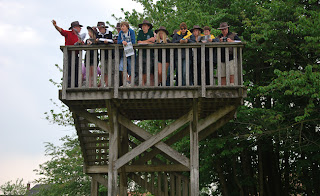Happy Easter! We awoke to another beautiful French morning, and all raced to breakfast in anticipation of a chocolaty surprise, but unfortunately it was not to be. For Lis Sandbach though, it meant sampling some delicious French chocolate croissants, as her Lent promise of no chocolate was now over.
Our first destination this morning was Delville Wood, the site of the South African Somme Memorial. This memorial contained over 5000 graves, 3500 of which were unidentified, suggesting the horrors of the battle. Over the course of the battle 400 shells were fired per minute on average. What was even more remarkable was the lone tree behind the memorial. It was the only tree left standing from the entire wood after the battle. As it began 3150 entered the wood, at the end only 143 men emerged, the rest were dead or wounded.
Our first destination this morning was Delville Wood, the site of the South African Somme Memorial. This memorial contained over 5000 graves, 3500 of which were unidentified, suggesting the horrors of the battle. Over the course of the battle 400 shells were fired per minute on average. What was even more remarkable was the lone tree behind the memorial. It was the only tree left standing from the entire wood after the battle. As it began 3150 entered the wood, at the end only 143 men emerged, the rest were dead or wounded.
Delville Wood is also now the resting place of some chocolate as well. It became the site of our Easter egg hunt, which started with eagerness and excitement, but ended with nettle stings and scratches! Nevertheless, we ended up with a haul of Easter eggs and after we applied the first aid, we were on our way to the next destination.
This was the Scottish memorial, which was also the memorial to bagpipers from across the Empire who served in WW1. It was decided that it might be fitting for the bagpipes to be played, so I took them out, and played a couple of times through “Amazing Grace” and the traditional Scottish tune “Scotland the Brave”. This was appreciated by the group, as well as several packs of enthusiastic cyclists, who were riding by, although as we were playing about 9.30 on a Sunday morning, in the middle of a village, we may have left a few angry French folk in our wake.
 |
| Tom, the tour's Kiwi, takes his place beside the Pipers' memorial |
 |
| Bruce outlines the horrors of Pozieres |
It was then off to Thiepval, and the massive Anglo-French memorial, a huge arch of brick and stone, similar to the Menin Gate, listing thousands upon thousands of the missing. Many of us were emotionally touched by this monument, which was located in idyllic countryside, especially when Bridget styodd beneath the central span and sang Amazing Grace for us. Many other visitors stopped and listened. One woman left the monument weeping inconsolably. Bridget described the experience as “the most moving part of the trip for me”.
We had a short time to get ourselves together on the way to lunch, which was up the road at the Irish memorial, where we were served soup and sandwiches by waitresses with a very Irish accents. This memorial was also important politically, with the IRA blowing up many memorials in Ireland during the '60s and '70s.
 |
| The SOAPs gather under the Moose of Newfoundland |
We also went to the Newfoundland memorial, which had original trenches, albeit a little repaired and maintained. Still, these gave us a powerful insight into life in the trenches, especially for me as my head poked over the top, leaving me vulnerable to enemy fire. A look around the Visitor’s Centre got us some new hat badges, this time featuring Canadian flags and poppies.
And finally, Villers-Brettoneux, one of the most important sites for Australians on the Western Front. We first went to Adelaide cemetery, where we had an adopted digger tribute from Bridget for her great-grandmother’s uncle.
We then found the grave from which a body of an unknown soldier was exhumed and buried at the Australian War Memorial as the Tomb of the Unknown Soldier. We each took turns to read lines from Paul Keating’s speech dedicating the Tomb in Canberra. It turned out to be an amazing, moving speech.
 |
| Bridget pays tribute to her family digger |
After Adelaide Cemetery, we went to the local school, Victoria School. It was built by donations from Victoria in the 1920s, and inscribed everywhere are the words “N’oublions jamais l’Australie” (Never forget Australia), reflecting the connection between us and this school. It also housed large museum of memorabilia from the war.
Our final stop was the Australian memorial, which was also the site of the ANZAC day service on the Western Front. We were put off by the television equipment, which covered the cemetery and made it hard to conduct tributes for Liz Smart's and Martin’s adopted diggers.
Yet we still managed, and as with all the tributes we were all deeply moved and saw the personal connection between the students and their diggers. We finished off with the Last Post on bugle and Waltzing Matilda on bagpipes. We finished off a bit earlier today, as we knew tomorrow would be the big day – ANZAC Day, and a 3:00 AM wake-up.
 |
| Martin and Liz remember their adopted diggers at Villers-Bretonneux |
Yet we still managed, and as with all the tributes we were all deeply moved and saw the personal connection between the students and their diggers. We finished off with the Last Post on bugle and Waltzing Matilda on bagpipes. We finished off a bit earlier today, as we knew tomorrow would be the big day – ANZAC Day, and a 3:00 AM wake-up.


No comments:
Post a Comment